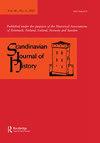斯堪的纳维亚的“吉普赛朋友”
IF 0.8
3区 历史学
Q1 HISTORY
引用次数: 0
摘要
摘要在这篇文章中,我们考察了一个特殊的“吉普赛朋友”形象是如何被战前两位开拓性的吉普赛人采用和发展的,他们是芬恩·阿瑟·特斯勒夫(1861–1920)和丹麦人约翰·米斯科夫(1862–1937)。我们认为,“吉普赛朋友”的形象是无畏的探险家、传教士无私的家长作风、无私的、探索的科学家和古怪的反资产阶级波西米亚人的综合体。在研究了这种男性形象在早期学术中是如何表达的,尤其是在有影响力的《吉普赛贵族社会杂志》中,我们转向Thesleff和Miskow,看看他们是如何采用、应用和修改这个比喻的,最后关注它对斯堪的纳维亚罗姆人的跨时代和战后待遇的影响。本文章由计算机程序翻译,如有差异,请以英文原文为准。
The Scandinavian ‘Gypsy friend’
ABSTRACT In this article we examine how a particular ‘Gypsy friend’ persona was adopted and developed by two pioneering pre-war Gypsylorists, the Finn Arthur Thesleff (1861–1920) and the Dane Johan Miskow (1862–1937). The ‘Gypsy friend’ persona, we argue, was a compound of the fearless explorer, the missionary’s selfless paternalism, the disinterested, questing scientist and the eccentric anti-bourgeois bohemian. After looking at how this masculine persona was expressed in earlier scholarship, not least the influential Journal of the Gypsy Lore Society, we turn to Thesleff and Miskow to see how they adopted, applied and revised the trope, with attention, finally, to its implications for inter- and postwar treatment of Scandinavian Roma.
求助全文
通过发布文献求助,成功后即可免费获取论文全文。
去求助
来源期刊

SCANDINAVIAN JOURNAL OF HISTORY
HISTORY-
CiteScore
1.10
自引率
20.00%
发文量
33
期刊介绍:
Scandinavian Journal of History presents articles on Scandinavian history and review essays surveying themes in recent Scandinavian historical research. It concentrates on perspectives of national historical particularities and important long-term and short-term developments. The editorial policy gives particular priority to Scandinavian topics and to efforts of placing Scandinavian developments into a larger context. Studies explicitly comparing Scandinavian processes and phenomena to those in other parts of the world are therefore regarded as particularly important. In addition to publishing articles and review essays, the journal includes short book reviews. Review essay proposals and polemical communications are welcomed.
 求助内容:
求助内容: 应助结果提醒方式:
应助结果提醒方式:


